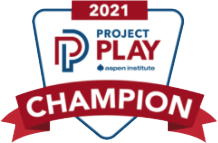Colorado Rapids Whole-Part-Whole Teaching Philosphy
Posted by: Kincaid Schmidt | Zone 1 Technical Director
Part 1: Play Practice Play = Whole Part Whole
The U.S. Soccer Federation (USSF) recently announced a welcome addition to it’s introductory licensing courses, formerly known as the “F” and “E” License Courses. The Grassroots Pathway provides coaches with an introduction to grassroots coaching and provides the prerequisites for further advanced licensing.
Grassroots soccer is “soccer for all,” bringing young people together to enjoy the sport for its physical, social, and psychological benefits. For most players, this takes plays through participation in programming and leagues at their local soccer club beginning at the youngest ages. While typically affiliated with younger age-groups, grassroots soccer exists at every level. “Whether that is a youth environment where players are experiencing organized soccer for the first time, or adults who are looking to learn more and get into the sport, grassroots soccer continues to be the bedrock of the sport.” (US Soccer)
At its core, the philosophy of grassroots soccer is the Play-Practice-Play Model. This model works to provide players with a learning experience that is realistic to the game and rooted in fun and enjoyment. According to the Play-Practice-Play Model, Grassroots coaches will begin training sessions with a game to Play, then walk players through activities for Practice, then finish the session with another Play opportunity.

Sound Familiar?
The Whole-Part-Whole Model is a teaching method used by the Colorado Rapids Youth Soccer Club. This age-appropriate curriculum is aimed at the long-term development of a soccer player. Youth club directors have collaborated with the Rapids Development Academy staff for over five years to refine the application of this model for every player in the club, from the grassroots level through competitive teams and on to the Development Academy. Youth club coaches plan training sessions that take players from a practice with high game context to a low one before returning back to the original practice.
What is the Whole-Part-Whole Model?
Whole: Conditioned game activity: larger group, more complex, more opponent pressure, high game context.
Part: Broken down/simplified/often smaller group activity, lower game context. (Can be with or without pressure.)
Whole: Conditioned game activity: larger group, more complex, more opponent pressure, high game context.
Why use the Whole-Part-Whole Model?
Whole 1: Promotes decision making, gives players pictures they may see in the game, allows coaches an opportunity to observe & identify.
Part: Simplifies pictures, often easier to perform so allows success, can focus on specific technique/skill which may allow more coaching information.
Whole 2: Allows players to attempt to transfer tasks performed in the ‘part’ back into the more complex decision making process and environment of a game.
Psychological Elements: Provides a natural rhythm to players’ learning.
How does the Whole-Part-Whole Model engage players mentally?
1st Conditioned Activity: The first whole introduces players to the training session’s content. This provides motivation and focused learning by revealing the objectives of the session’s concluding exercises. Opening training with this creates a framework for players to understand the information they are being presented.
Isolation Activity: Most content detail is not retained through simply performing the part alone. The brain performs a simplification effect often only retaining the most outstanding pieces of the ‘part’ content once the learner moves away from this element. This is why the whole needs to be introduced and revisited.
2nd Conditioned Activity: The final piece links the session parts back together to form the whole. Association and recall allows the learner to return to a ‘whole’ situation and link ‘parts’ together. We allow the brain’s memory to recall more detail of the ‘part’ content by giving context before and after. In order for this recall to take place, the second whole must be organized in a way which resembles the first whole.
Whole-Part-Whole Model Application
All youth club coaches receive in-depth education on the Whole-Part-Whole model and must not only demonstrate the ability to properly format a session. The Whole-Part-Whole method is not effective without the coaches’ understanding of why they’ve chosen certain games and isolation activities as well as how to properly connect these components for maximum player development.
Our aim is to foster a deep and complete understanding of the content that we teach to the point where we produce high level cognitive thinkers within the context of the game of soccer. It is exciting to see other leaders in the soccer development world embracing progressive models to help players enjoy the game.









